Description
Akara, or beans fritters, is a popular Nigerian savory (vegan) fitter made with beans, mainly black-eyed peas. akara, also known as beans cakes, beans balls, koosé, or acarajé, is a famous street food across Africa and beyond. Across most Nigerian cities, you find akara spots in the mornings and evenings. Akara sellers would typically set up their market and start to make/fry fresh akara balls. Also, akara pairs well with corn pudding, bread, custard, as well as very delicious just by itself.
Ingredients
- Black-eyed peas (1 lb. bag or less/more)
- ½ big onion or 1 medium size Onion
- 1– 2 Fresh big bell peppers (Red or orange color preferably. I like using red/reddish bell peppers for this recipe.)
- 1 habanero (for that spicy kick; add more if you like it more spicy)
- Salt and crushed red pepper to taste
- Oil for frying (I normally use peanut oil, and at least 3 inches deep)
- Red pepper flakes (optional)
Instructions
- STEP 1: Have raw/dry black-eyed peas on hand. Akara starts with dry beans; have it on hand. These days, I primarily use black-eyed beans; however, Nigerian brown beans are great, too. Simply put, you cannot make authentic akara without raw/dry beans. I have heard about people using “beans flour.” That would be a story for another day! But I do not recommend it.
- STEP 2: Peel/Deskin Beans. Traditionally, you add some water to the beans and continue to rub the wet beans between your palms to remove their skins. As tedious as it sounds, that’s how it’s done. And that’s how my mom taught me how to do it growing up. Currently, I use the blender or food processor to peel/de-skin/wash off bean skins. Follow this instruction to easily and quickly peel/deskin beans without tears.
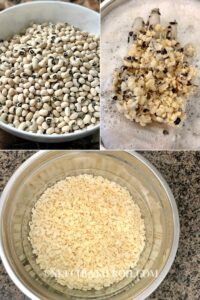
- STEP 3: Blend (Peeled) Beans. Wash/cut onions, bell peppers, habanero, and set aside. Add some of those peeled beans, sliced onions, bell pepper, and habanero to the blender. Add a little water and blend for a paste-like consistency. Only add a little water when blending, as you don’t want a watery or runny batter. I don’t recommend more than one cup of water for 1 pound of black-eyed peas beans. Then, blend for a smooth, almost silky consistency. Pour the mixture into a bowl. Repeat the process to blend all the beans. Note: use a high-speed blender and not a food processor to blend the beans.
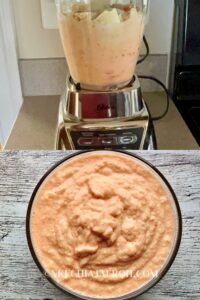
- STEP 4: Season Beans Paste. Season the paste with salt shortly before frying. Typically, I prefer to season the paste as I go. This means I season a bowl of paste before frying it. Here’s how: add about a cup (or more) into a small bowl or mortar, then add a little salt and stir with a pestle or spoon. (Important Note: if you have a mortar and pestle, use them. The pestle serves a great purpose. “Grinding” the paste in a circular motion with the pestle helps to eliminate air from the paste and further “prepares” it for frying. And if you do not have a mortar and pestle, use a bowl, as explained above. Taste and adjust as needed, and next is frying time. Remember, a little salt goes a long way; add in small increments. You can also add red pepper flakes.
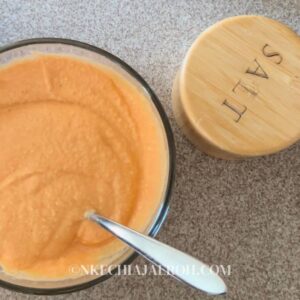
- STEP 5: Fry Akara Balls. The best part of the work begins with frying. To fry akara, first, add enough frying oil up to 3 inches deep. Second, heat the oil, preferably on medium heat. Allow the oil to heat up, but make sure the oil is not too hot. Then, use a tablespoon measuring spoon to add the paste to the hot oil. Note: do not overcrowd the pot. Third, when the underside turns brown, use a fork or wooden skewer to flip the balls so the other side cooks as well. When both sides of the akara balls are cooked, use a strainer skimmer ladle to scoop them off the oil and place them on a paper towel-lined plate. Fourth, fry in batches. Finally, repeat this step to fry all the paste/batter.
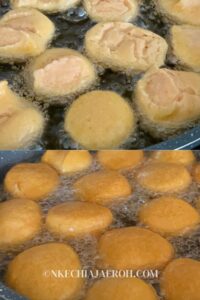
- STEP 6: Serve and Enjoy as You Wish! Serve and eat akara with bread, custard, or pap. These Nigerian akara balls make a perfect weekend breakfast and snacks! Yummy!!
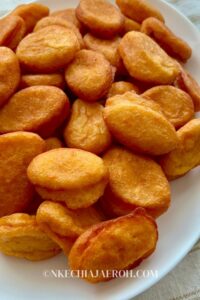 WATCH THE RECIPE VIDEO TUTORIAL ⬇️
WATCH THE RECIPE VIDEO TUTORIAL ⬇️
Notes
Usually, the exact quantity of the ingredients will depend on the amount of akara you want to make. If you are new to akara, you start with 1 – 2 cups of dry beans. Adjust as you wish. Look at my beans paste, and possibly model yours that way.
Add onions, fresh bell peppers, habanero according to your taste. Typically Nigerian AKara doesn’t need other spices such as Maggi, curry, thyme, nutmeg, etc. That’s why those spices aren’t included in this recipe. Akara is super simple and naturally tastes better that way. However, you do you when you are in the kitchen!
Do not use too much water to blend your Akara beans. Usually, Akara paste is thicker than moi-moi paste.
Do not overcrowd the pot while frying the fritters
Avoid overheating the oil; if it is too hot, the outside of the fritters might cook while the inside is still raw.
While frying the Akara, be mindful not fill up the pot with too many Akara balls.
Depending on the size of your pot, add Akara paste to cover only half of the pot because the Akara will rise and likely double in size. They need space to cook properly.
Please do not add (too much) salt to Akara paste as you would do in regular meals. Akara requires a minimal amount of salt because it goes a long way, if not, your Akara will be too salty and almost un-edible. The trick is to add a little increment of salt and taste for flavor. Then you can add (small) salt according to your liking (or health need); you can also add more peppers, and then fry.
Usually, the serving size of Akara will depend on how big or small the balls are; I make mine small just like photos on this post and I eat plenty.🤣😊🤷🏾♀️

